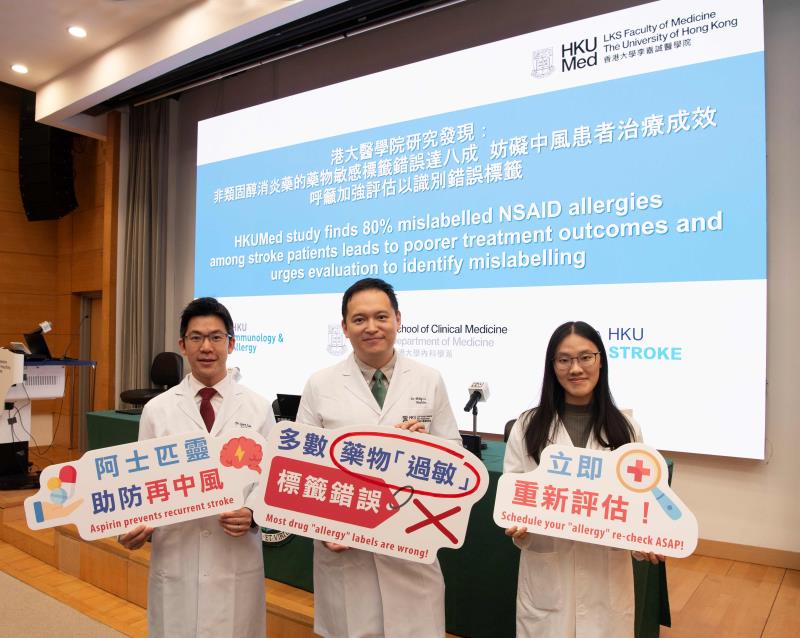Stroke patients with NSAID allergy labels have poorer treatment outcomes




 From left: Dr Gary Kui-Kai Lau, Dr Philip Hei Li and MBBS student Cheryl Cheuk-Wun Tsui
From left: Dr Gary Kui-Kai Lau, Dr Philip Hei Li and MBBS student Cheryl Cheuk-Wun TsuiStroke patients with NSAID allergy labels have significantly higher mortality, peripheral vascular disease (PVD) and major adverse cardiovascular events (MACE) than those not labelled with NSAID allergies, and the rate of mislabelled NSAID allergy is high, a study by the University of Hong Kong (HKU) has found.
The combined retrospective longitudinal and cross-sectional study, which analyzed electronic healthcare records in Hong Kong, compared the prevalence of allergy labels among the general population (n=7,337,778) and patients who presented with acute ischaemic stroke to a territory hospital under the Hospital Authority from 2008 to 2014 and attended regular follow-up (stroke cohort, n=1,003). [Stroke 2025;56:30-38]
The study revealed that the five most common drug allergy labels for both the general population and the stroke cohort were for the following British National Formulary Drug Classes: anti-infectives, cardiovascular (CV) and haematopoietic system, central nervous system (CNS), eye, and radiographic and diagnostic agents.
Patients with a history of stroke had significantly more allergy labels than the general population for CV and haematopoietic system agents (odds ratio [OR], 2.40; 95 percent confidence interval [CI], 1.74–3.32; p<0.001) and radiographic and diagnostic agents (OR, 4.82; 95 percent CI, 2.56–9.08; p<0.001).
Among the stroke cohort, the most common allergy label was for NSAIDs (prevalence, 1.8 percent), and the most common individual drug allergy labels were for aspirin (23.9 and 32.4 percent in the CV and haematopoietic system and CNS classes, respectively) and diclofenac (31.3 and 14.7 percent in the eye and CNS classes, respectively).
These NSAID “allergic” stroke patients (n=18) were less likely to be prescribed aspirin after acute stroke (OR, 0.24; 95 percent CI, 0.09–0.60; p=0.003) and on follow-up (OR, 0.22; 95 percent CI, 0.08–0.56; p=0.002) compared with those without NSAID allergy labels. Significantly higher risks of mortality (OR, 7.44; 95 percent CI, 2.44–23.18; p<0.001), PVD (OR, 9.35; 95 percent CI, 1.95–44.86; p=0.005) and MACE (OR, 6.09; 95 percent CI, 2.00–18.58; p=0.001) in the poststroke period were also found in this group of patients.
Alarmingly, when the NSAID “allergic” stroke patients (who remained alive and could give consent, n=5) were referred for allergist assessment and offered drug provocation testing, 80 percent of them had negative provocation tests and were delabelled.
“Patients were astonished to learn that the allergy labels they have had for years were incorrect, and that they could have safely used aspirin,” said Cheryl Cheuk-Wun Tsui, an undergraduate medical student and lead investigator of the study.
“Our study revealed that the majority of drug allergy labels in Hong Kong may be inaccurate, yet most patients have never been properly evaluated for drug allergies,” noted Dr Phillip Hei Li, supervisor of the study. “These mislabelled allergies leave patients with no choice but to use less effective medications, putting them at significant health risks, with potentially dangerous or even fatal consequences.”
Li emphasized the urgent need to expand drug allergy testing services in Hong Kong. He advocated innovative strategies, such as empowering community pharmacists to lead drug allergy evaluations in collaboration with HKU’s Faculty of Medicine. He believed that this approach would address current gaps in the healthcare system and promote better patient outcomes and overall public health.